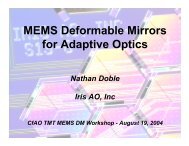PSF reconstruction for Keck AO - Laboratory for Adaptive Optics
PSF reconstruction for Keck AO - Laboratory for Adaptive Optics
PSF reconstruction for Keck AO - Laboratory for Adaptive Optics
You also want an ePaper? Increase the reach of your titles
YUMPU automatically turns print PDFs into web optimized ePapers that Google loves.
3 COMPONENT MODELING 17Figure 4: Schematic of <strong>AO</strong> temporal control loop (top) and a blowup of the WFS model (bottom). E and G are spatialmatrix mappings, independent of time, while S, R, C and D are temporal filters, generally matrix-valued but assumed in thisanalysis to be scalar filtersc = [0, 1.16136, 2.97422, −13.2381, 20.4395] (59)p 1 = a 0 + a 1 β + a 2 β 2 + a 3 β 3 (60)p 2 = b 0 + b 1 β + b 2 β 2 + b 3 β 3 (61)p 4 = c 0 + c 1 β + c 2 β 2 + c 3 β 3 (62)p 3 = (pp2 4 β − 1+p−p1 4 )− log p 4(63)where the a, b and c parameters were obtained (not by me) from a fitting procedure. This influence function is shownin the middle panels of Fig. 3, where I also include a simple bilinear influence function (rightmost panels of Fig. 3).3.4 Covariance matrix 〈ɛɛ T 〉Exact temporal modeling of the residual mode covariance matrix 〈ɛɛ T 〉 turns out to be problematic, and most <strong>PSF</strong><strong>reconstruction</strong> implementations so far have applied varying levels of approximation to this aspect of the systemmodeling. Referring to the generic <strong>AO</strong> block diagram in Fig. 4, we can examine the loop dynamics in terms ofthe phase modal coefficients a (input turbulence), c (DM mode) and ɛ (residual error). The other variables are: s 0is an ideal noise-free and aliasing-free WFS measurement; n is the noise and r is the aliasing, and s is the actualWFS measurement, assuming the components add linearly; the u and y are internal variables used in defining thecompensator. The s and c vectors are the only ones which we have access to from <strong>AO</strong> telemetry data, and which wemust employ in order to estimate 〈ɛɛ T 〉.A subtlety to be aware of is that the low- and high-spatial-frequency modal sets φ ‖ and φ ⊥ were defined by theDM modal basis h i (x), and strictly speaking this need not be equivalent to the subsets of φ that are aliasing-freeand produce aliasing in the WFS, respectively. Hence, the aliasing r can not be said to have come solely from φ ⊥ ,since the DM influence functions themselves may produce a (very small) amount of aliasing. In practice, however,in a Fried-geometry Shack-Hartmann <strong>AO</strong> system, the modal basis of the DM influence functions and the basis thatis aliasing-free are very close to each other, and to a first-order approximation we can say that aliasing only arisesfrom φ ⊥ (and hence ɛ ⊥ ).To remind ourselves of the context, we are trying to calculate 〈ɛɛ T 〉 because it arises in the residual wavefront



